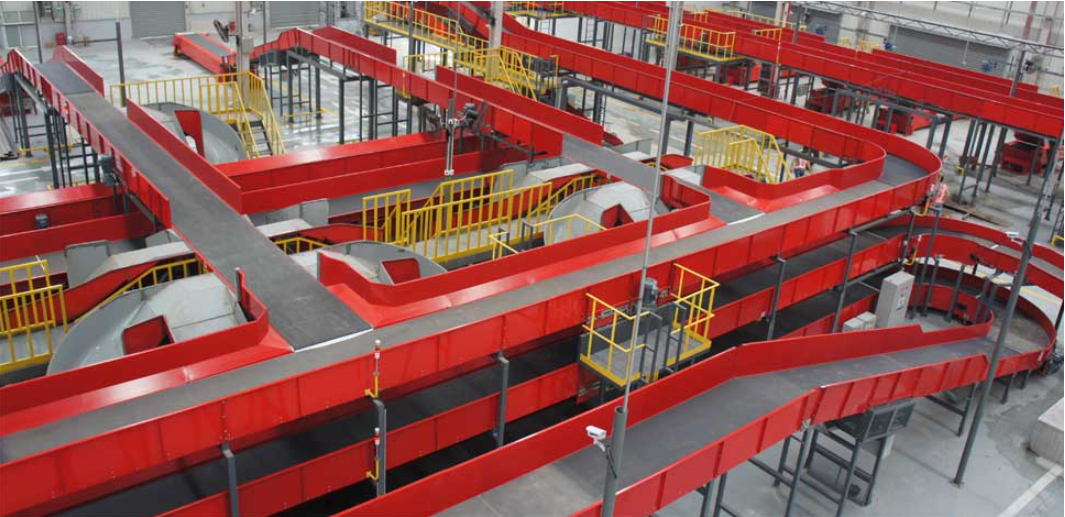CHD Belt Conveyor: Reshaping the Logistics Lifeline with Intelligent Transport "Arteries," Ushering in an Era of Unmanned and Efficient Operations
Release Time : 2025-09-08
Driven by the dual trends of Industry 4.0 and intelligent logistics, traditional manual handling is rapidly disappearing. Statistics show that labor costs in my country's logistics industry have increased by over 8% annually, while sorting errors and handling accidents remain high. With their core advantages of efficiency, stability, and flexibility, CHD belt conveyors have become a key infrastructure for building modern intelligent logistics systems. They not only enable unmanned and automated material transportation but also, as "transport arteries," reshape the efficiency of the entire chain from warehousing, production, and distribution.
1. From "Labor-Intensive" to "Unmanned": The Transformative Power of CHD Belt Conveyors
In traditional logistics scenarios, manual sorting and handling account for over 60% of the work, resulting in low efficiency, high costs, and high error rates. The CHD belt conveyor revolutionizes this model with its continuous, automated conveying design:
24-hour non-stop operation: At a standard conveying speed of 100 meters per minute, a single CHD belt line can handle over 5,000 cubic meters of material daily, equivalent to the full workday of 20 workers.
Intelligent linkage control: Seamlessly integrates with WMS (Warehouse Management System) and PLC (Programmable Logic Controller) systems to automate the entire process from order allocation, routing, and equipment startup and shutdown.
Zero-contact sorting: Incorporating photoelectric sensors and barcode recognition technology, it accurately sorts and distributes goods, increasing sorting accuracy to over 99.9% and completely eliminating the risk of manual error.
Case Study:
After implementing the CHD belt conveyor system in the East China warehouse of an e-commerce giant, labor costs were reduced by 45%, order processing time was shortened from 4 hours to 45 minutes, and cargo damage caused by handling was reduced by over 2 million yuan annually.
2. Technological Breakthrough: Three Core Advantages of CHD Belt Conveyors
1. Superior Stability: The "Backbone of Conveyors" adapted to high loads and complex working conditions
Modular Roller Design: Utilizing high-precision bearings and seals, rollers offer a lifespan exceeding 50,000 hours and a failure rate below 0.3%, ensuring continuous, uninterrupted operation.
Intelligent Tensioning System: Automatically adjusts belt tension through hydraulic or gravity forces to prevent slippage and deviation, and is suitable for operating in extreme environments ranging from -25°C to 50°C.
Heavy-Duty Load Capacity: The main frame is constructed of Q345B high-strength steel, with a maximum single-point load of 2 tons, enabling stable conveying of heavy materials such as ore and steel.
2. Flexible Layout: Optimizing both space utilization and scalability
Multi-configuration: Supports horizontal, inclined, curved (maximum curvature radius of 3 meters), and crisscross layouts, easily adapting to unusual spaces such as warehouses, workshops, and docks.
Quick Assembly and Disassembly Structure: Utilizing bolted connections and adjustable legs, equipment relocation or expansion cycles are reduced to one-third of traditional designs.
Multi-machine Collaborative Network: Utilizing a distributed control system, over 10 conveyor lines can be connected in series to form a conveyor matrix, enabling cross-regional material flow.
3. Energy Saving and Consumption Reduction: A "Low-Carbon Engine" for Green Logistics
Variable Frequency Drive Technology: Automatically adjusts motor power based on load, saving over 30% energy compared to traditional fixed-speed conveyors.
Low-Resistance Roller Design: Chrome-plated surfaces and precision bearings reduce the operating friction coefficient to 0.02, minimizing energy loss.
Energy Recovery Device: Optional brake energy recovery system converts kinetic energy during deceleration into electrical energy that is fed back to the grid, reducing overall energy consumption by an additional 15%.
3. Scenario Empowerment: CHD Belt Conveyor Applications Across Industries
1. Smart Warehousing: Creating Core Flows for "Dark Warehouses"
In automated warehouses, CHD belt conveyors serve as the primary horizontal transport mechanism, forming an integrated "air-ground-air" logistics network alongside stacker cranes and AGVs (Automated Guided Vehicles). For example, an automotive parts warehouse connects 12 aisle stacker cranes via CHD belt lines, achieving error-free loading and unloading of an average of 20,000 pieces of goods daily.
2. Manufacturing: Connecting the Entire "Raw Materials to Finished Product" Process
In process-intensive industries such as steel and chemicals, CHD belt conveyors can seamlessly connect equipment such as crushers, reactors, and packaging lines to create continuous production lines. A cement plant uses high-temperature-resistant belt conveyors (operating at temperatures up to 150°C) to increase clinker transportation efficiency by 40% and reduce annual downtime and maintenance by 200 hours.
3. Cross-border Logistics: Addressing the Challenges of "Super-Scale and Super-Long Distance"
In hubs such as ports and airports, CHD belt conveyors, with their long distances (up to 3 kilometers per line) and high inclination angles (up to 25°), enable efficient transfer of containers and bulk cargo. For example, the CHD belt system deployed at Qingdao Port's Qianwan Terminal handles over 100,000 tons of bulk cargo per day, doubling efficiency compared to traditional loading and unloading methods.
4. The Future Has Arrived: The Intelligent Upgrade Path for CHD Belt Conveyors
With the penetration of technologies like AI and digital twins, CHD belt conveyors are evolving from "automated equipment" to "intelligent logistics units":
Predictive Maintenance: Vibration sensors and edge computing monitor equipment health in real time, providing 30-day advance warning of failures.
Adaptive Scheduling: Based on deep learning algorithms, conveyor routes and speeds are dynamically optimized to address order fluctuations and unexpected demand.
Unmanned Inspection: Inspection robots equipped with 5G and machine vision can automatically identify potential hazards such as belt tears and stuck rollers, achieving "zero-manual inspection."

From liberating labor to defining efficiency, from single equipment to intelligent networks, CHD belt conveyors are no longer just a "conveyor" for logistics systems; they are the "core engine" driving the industry toward unmanned, flexible, and green operations. Amid the dual pressures of rising labor costs and carbon neutrality goals, choosing CHD belt conveyors means choosing a path to cost-saving, efficiency-enhancing, and sustainable logistics upgrades.
Let every conveyor line become an "accelerator" for your company's competitiveness!








